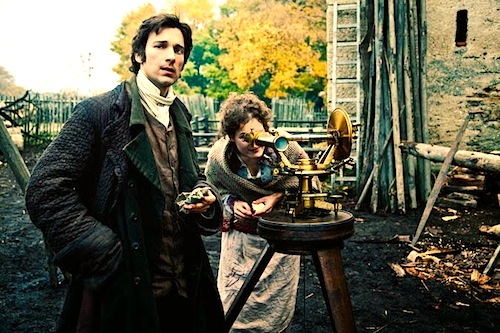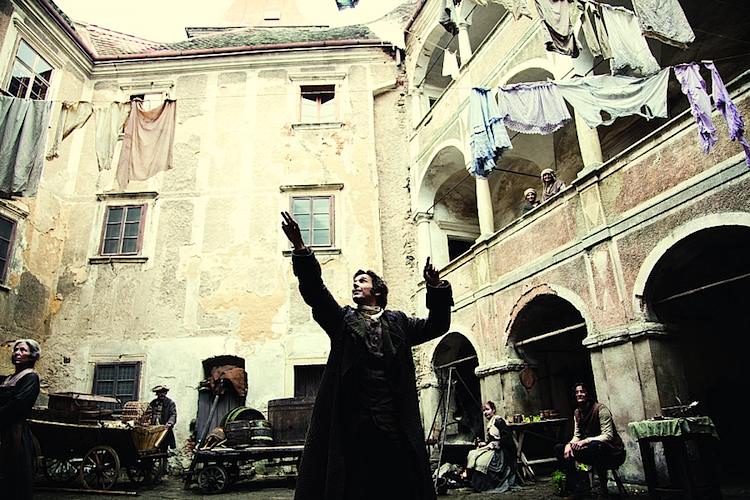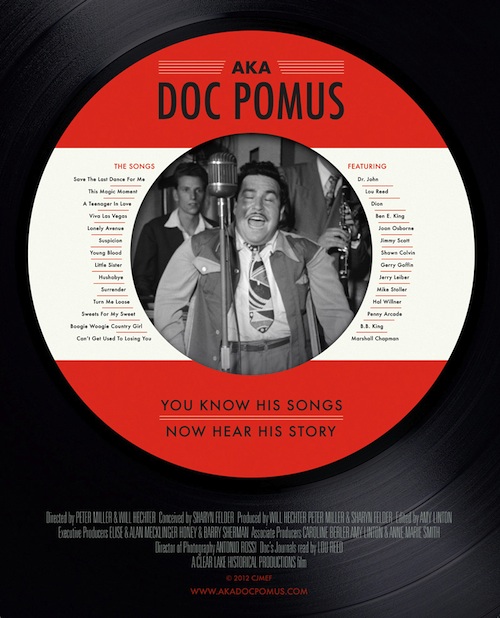By Joe Bendel. You know Gauss’s bell curve and you know Humboldt’s monkey. They were two of the most celebrated intellects of the Nineteenth Century German states. In addition to a common patron, Austrian Daniel Kehlmann’s fictionalized dual-biography suggests they also perhaps shared an intertwined fate. Adapted for a big, big screen by the novelist himself, Detlev Buck’s Measuring the World, has its American premiere this Friday as the opening night film of German Currents 2013 in Los Angeles.
Carl Friedrich Gauss was born into desperate poverty, but the boy’s stern schoolmaster recognized his remarkable gift for mathematical analysis. With a name like Friedrich Wilhelm Heinrich Alexander von Humboldt, the future Prussian naturalist-explorer was clearly a child of privilege. However, the Duke of Brunswick supported both lads’ education at an early age.
After Gauss and Humboldt meet by chance as children, Measuring splits into two wildly divergent narratives. A mathematician in the purest form, Gauss will spend his life within the German states. He is difficult by nature, yet somehow the uneducated but supportive Johanna consents to marry him. Meanwhile, Humboldt embarks on a Latin American expedition that will make his name. His most significant companion will be his colleague and uneasy friend, Aimé Bonpland, the French botanist. As the title suggests, both men will take vastly different approaches to quantifying our earthly bounds through their work. Eventually, Humboldt and Gauss will meet again in their twilight years, carrying the baggage of two eventful lives.

For a prestige period production, Measuring has a surprisingly idiosyncratic sensibility. With its archly ironic narration and fits of absurdist humor, the film often feels like a distant cousin of Gilliam’s Munchausen. Visually, it is often quite inventive and the sheer scope of its wanderings is rather impressive. Yet, there are some nice, quiet moments shared between Florian David Fitz and Vicky Krieps, as the Gausses. At times, Albrecht Abraham Schuch risks veering into Fraser Crane territory as the adult Humboldt, but Jérémy Kapone’s earthier Bonpland helps compensate for and undercut his mannered fastidiousness.
Ironically, one of the most recognizable faces in Measuring for American audiences will be Karl Markovics (lead actor in Stefan Ruzowitzky’s The Counterfeiters), who is quite good in the very supporting role of young Gauss’ teacher, Büttner. Cineastes will also be intrigued to hear that the film was lensed by Krzysztof Kieslowski’s longtime cinematographer Sławomir Idziak. Measuring does not look like a Kieslowski, but it has a distinctive sheen nonetheless.
With Idziak and his talented crew, Buck immerses viewers in an era Americans do not often have the opportunity see on screen. Granted, Measuring is somewhat inconsistent in patches, but when it works, it works on a very high level. Recommended for fans of cerebral historicals, like Longitude and Pillars of the Earth, Measuring the Earth screens this Friday (10/4), kicking off this year’s German Currents at Egyptian Theatre. It should also be noted in closing: Measuring is one of three Match Factory films screening as part of the celebration of German cinema, along with Gold and Layla Fourie.
LFM GRADE: B
Posted on October 3rd, 2013 at 5:16pm.

